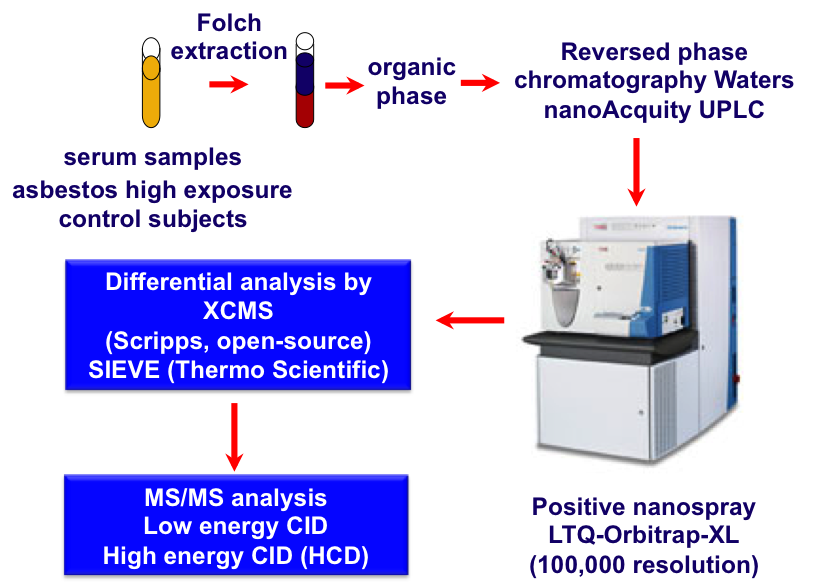Project 6: Biomarkers of Asbestos Exposure
Significance
All forms of asbestos including the amphiboles (crocidolite, amosite, tremolite, actinolite, and anthophyllite) as well as the serpentine form chrysotile, cause mesothelioma and cancer of the lung. Therefore, it would be highly desirable to have available sensitive and specific biomarkers of asbestos exposure in order to assess potential inter-individual risks of developing mesothelioma or lung cancer. In on-going studies, we are developing serum metabolomic markers of exposure to asbestos.

Project 6 is employing nanospray ultraperformance liquid chromatography (UPLC) in combination with high resolution tandem mass spectrometry (MS/MS). Individual samples are extracted with a suitable solvent (Folch extraction) then aqueous and organic phases are subjected to analysis by high resolution nanospray UPLC-MS. Individual chromatograms are aligned using a combination of open-source and proprietary software. Chromatograms from control samples are then interrogated against experimental samples for differences in intensity of each MS signal. Identification of metabolites is conducted by using different modes of MS/MS analysis. These studies have resulted in the generation of a rich data-set of biomarkers, in which a number of metabolites are dysregulated in asbestos exposure when compared with control non-exposed individuals.
Hypothesis
We will test the hypotheses that:
- Asbestos exposure will increase oxidative stress as revealed by current serum oxidative stress biomarkers.
- Metabolomics analysis of serum using ultra-high resolution LC-MS will reveal novel biomarkers of asbestos exposure and mesothelioma that can be characterized using modern bioanalytical techniques.
- Profiling of human serum proteins will identify signatures of asbestos exposure and mesothelioma.
These hypotheses will be tested under the following three Specific Aims:
- To quantify biomarkers of oxidative stress and identify and quantify differentially secreted metabolites in the serum of human subjects exposed to asbestos, serum from subjects with mesothelioma, and control serum from normal unexposed control subjects.
- To quantify biomarkers of oxidative stress and identify and quantify differentially secreted metabolites in asbestos-exposed immortalized mouse cells and serum provided by Project 4 from mice genetically engineered to develop mesothelioma compared with isogenic non-exposed mice.
- To analyze serum HMGB1 and profile serum proteins in asbestos-exposed and unexposed individuals to identify asbestos exposure biomarkers and to analyze serum fibulin-3 as a mesothelioma biomarker to complement serum metabolomic biomarkers obtained in Aim 1.
An important translational impact would be the use of biomarkers for monitoring disease prevention and treatment as well as the identification of individuals at risk for follow-up studies. It will be possible to identify particular individuals who have been exposed to asbestos and have a high risk profile for careful clinical monitoring or asbestos-exposed individuals lacking a high risk profile. Project 6 will interact strongly with Projects 4 and 5. Analysis of the oxidative stress biomarkers by Project 6 will provide important evidence to establish whether this is a realistic mechanism.
Additional substantial interactions with Project 1 will arise through the use of remediated asbestos in the mouse models. Project 6 will conduct research through the efforts of two graduate students who will be part of the Interdisciplinary Research Training Core. The students will also contribute to the diversity of scientific expertise through their biomarker studies. They will also participate in the research and seminars that promote cross-disciplinary interactions. Project 6 will work closely with the Biostatistics Research Support Core for biomarker discovery and validation in animal models and in human subjects. The data obtained from human subjects will be provided to the Research Translation Core and the Community Engagement Core where we believe they will have significant translational impact for risk assessment and management in asbestos exposed communities. There will be a strong interaction with the Administrative Core for report preparation and fiscal oversight.
Project Leaders
Ian A. Blair, PhD, Project Leader
A.N. Richards Professor, Department of Systems Pharmacology and Translational Therapeutics, Perelman School of Medicine, University of Pennsylvania
ianblair@upenn.edu
Anil Vachani, MD, Co-Project Leader
Assistant Professor, Department of Medicine, Perelman School of Medicine, University of Pennsylvania
avachani@pennmedicine.upenn.edu
Publications
Click Here to view all publications

